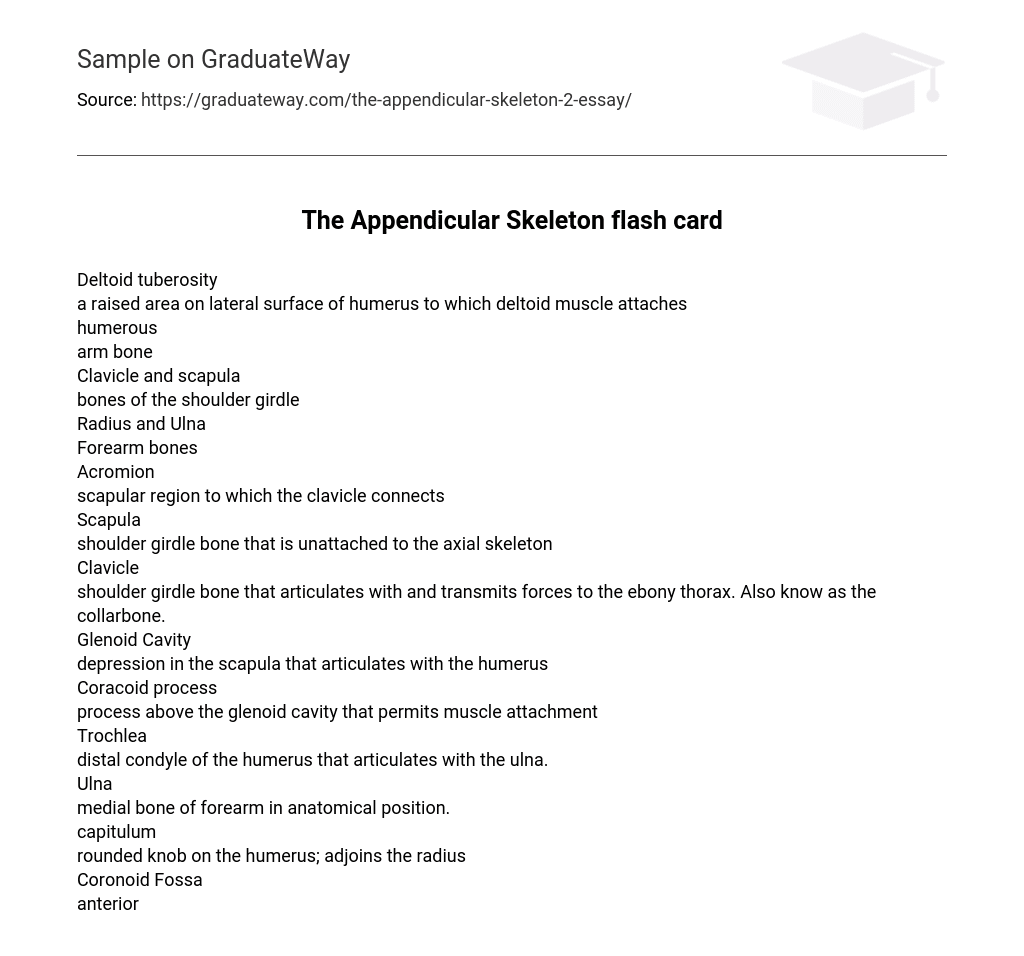Deltoid tuberosity
a raised area on lateral surface of humerus to which deltoid muscle attaches
Clavicle and scapula
bones of the shoulder girdle
Radius and Ulna
Forearm bones
Acromion
scapular region to which the clavicle connects
Scapula
shoulder girdle bone that is unattached to the axial skeleton
Clavicle
shoulder girdle bone that articulates with and transmits forces to the ebony thorax. Also know as the collarbone.
Glenoid Cavity
depression in the scapula that articulates with the humerus
Coracoid process
process above the glenoid cavity that permits muscle attachment
Trochlea
distal condyle of the humerus that articulates with the ulna.
Ulna
medial bone of forearm in anatomical position.
capitulum
rounded knob on the humerus; adjoins the radius
Coronoid Fossa
anterior depression superior to the trochlea, which receives part of the ulna when the forearm is flexed
Ulna
Forearm bone involved in formation of the elbow joint
metacarpals
heads of these bones form the knucles
scapula and sternum
bones that articulate with the clavicle
How is the arm held clear of the widest dimension of the thoracic cage
the clavicle acts as a strut to hold the glenoid cavity of the scapula(therefore the arm) laterally away from the narrowest dimension of the rib cage.
What is the total number of phalanges in the hand?
14
What is the total numbers of carpals in the wrist
8
Name the carpals (medial to lateral) in the proximal row.
pisiform, triquetral, lunate, scaphoid
Name the carpals in the distal row (medial to lateral)
hamate, capitate, trapezoid, trapezium
The Humerus is a right bone in a posterior view
…
The radius and ulna are right bones in an anterior view.
…
Pectoral bones
Flexibility most important
Light weight
Insecure axial and limb attachment
Pelvic Bones
Massive,
Secure axial and limb attachements
weight bearing most important
What organs are protected at least in part by the pelvic girdle
Uterus(female), urinary bladder, small instestine, rectum.
Distinguis between the true pelvis and the false pelvis
The true pelvis is the region inferior to the pelvic brim, which is encircled by bone. The false pelvis is the area medial to the flarin iliac bones and lies superior to the pelvic brim.
Deduce why the pelvic bone of a four-legged animal such as the cat or the pig are much less massive than those of the human.
The pelvic girdle does not have to carry the entire weight of the trunk in the quadruped animal
A persons instinctively curls over his abdominal area in times of danger ..
abdominal area organs receive the least protection from the skeletal system…
For what anatomical reason do many woman appear to be slightly knock-kneed
the pelvis is broader and the acetabula and ilia are more laterally positioned. Thus the femur runs downward to the knee more obliquely than in the male.
How might this anatomical arrangement contribute to knee injuries in female athletes
the more oblique angle in female causes greater fores on the anterior cruciate ligament ACL during knee rotation and the smaller the female intercondylar notch can pinch the ACL during twisting or hyperextended movements. Both events can cause a tear rupture of the ACL
What does fallen arches mean
a weaking of the tendons and ligaments supporting the arches of the food.
Fuse to form the coxal bone
ilium, ischium and pubis
sit down bone of the coxal bone
ischium
point where the coxal bones join anteriorly
pubic symphysis
superiormost margin of the coxal bone
iliac crest
deep socket in the coxal bone that receives the head of the thigh bone
acetabulum
joint between axial skeleton and pelvic girdle
sacroiliac joint
longest strongest bone in body
femur
thing lateral leg bone
fibula
heavy medial leg bone
tibia
medial ankle projection
medial malleolus
lateral ankle projection
lateral malleolus
largest tarsal bone
calcaneus
bones forming the instep of the foot
metatarsals
opening in hip bone formed by the public and ischial rami
obturator foramen
sites of muscles attachment on the proximal femur
gluteal tuberosity and greater and lesser trochanters
tarsal bone that sits on the calcaneus
talus
weight bearing bone of the leg
tibia
tarsal bone that articulates with the tibia
talus
Remember! This essay was written by a student
You can get a custom paper by one of our expert writers
Order custom paper
Without paying upfront

